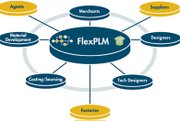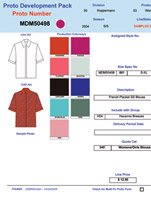Wave of the Future
Product Lifecycle Management software, while not new, has just begun to ride the crest of the wave
Southern California may be the original surfing epicenter, but there are legions of wave riders in Australia and France, two of the top foreign markets for Huntington Beach–based Quiksilver. And while all surfers share the same passion for sun, sand, and foam, there are subtle regional differences when it comes to fashion—differences that Quiksilver must address to be first up on the wave of prosperity.
That's why Quiksilver uses a Product Lifecycle Management software application, so its worldwide design offices can all have access to the new season’s products—and all the sketches and photos associated with them—yet easily customize colors, sizes, and other specifications for regional markets.
“Quiksilver is a global lifestyle brand, and one of the things they do really well is incorporate the customer requirements in different demographics all over the world,” says Tamara Saucier, director of retail industry solutions for MatrixOne, Quiksilver’s PLM provider. “They have design and sourcing organizations in the U.S., Australia, and France, where surfing culture is based, and they’re able to collaborate globally on design and trends.”
Billion-dollar companies like Quiksilver have been using PLM since the dawn of the new millennium, but PLM providers say the topic only became hot last year. Now even small but growing companies see the necessity of having a software application that manages the entire lifecycle of a product’s development, from the first ideas and sketches to its arrival on retail shelves.
SPOT ON AND RED HOT
Product Lifecycle Management is the natural evolution of Product Data Management. But whereas PDM was more proprietary and static, PLM is shared, Web-based, and changes as fast as business does. PLM is essentially a database on a company network, but because it is Web-based, it can be accessed around the world by remote offices and business partners—any computer with an Internet connection. As products go from design to production, PLM manages the reams of data associated with the items, including colors, measurements, and materials; samples sent to multiple subcontractors; sourcing; seasons; billing; marketing; and everything else associated with running a business.
MatrixOne, which was acquired last year by DassaultSystemes, holds a 23 percent worldwide market share in PLM across all industries. After years of serving the automotive and aerospace industries, in 2005, the company introduced the MatrixOne Accelerator for Apparel Design and Development. MatrixOne’s customers include Adidas, New Balance, and Guess. In some industries, MatrixOne’s PLM applications handle 50,000 users and a million data transactions per year.
And its apparel-industry customer base is growing rapidly.
“The biggest drivers to PLM today are based on what’s happening in the industry,” explains Saucier. “In the apparel industry today, and retail in general, we see a lot of focus on speed-to-market. Everybody’s talking about it, and what it’s doing is compressing companies’cycle time, so they have more seasons, more collections, and more products, combined with smaller order cycles.
“It’s putting a lot of stress on organizations in terms of more detailed information,” she continues, “requiring them to be collaborative with their providers and partners. And historically this has all been managed in an Excel spreadsheet.”
Needless to say, Excel spreadsheets used by various company departments all tracking the same product tend to produce multiple versions of “the truth.” PLM not only provides accuracy, it lets a company 0design closer to the season, ensuring its fashion forecasting is spot on and its products red hot.
FAST FASHION
There was a time when clothing changed slowly over years, even decades. Those times belong to the fashion history books. In the Internet-fueled Information Age, trends catch on—and die out—faster than a change of clothes.
“If you think about industry trends like fast fashion, reduced cycle times, and designing closer to delivery,” says Kathleen Mitford, vice president of vertical market strategies for PTC, “in order to support these, companies need to have solutions that will allow them to get product to market quicker.”
And speed-to-market is no longer just a competitive edge: It’s necessary just to stay in the game. “Consumers are conditioned now that when they go into a store like H&M they’re going to have a new product mix on the floor,” says Mitford. “Whereas consumers used to shopfour or six times per year, now they go every two weeks and expect a new mix on the floor. Also, because the Internet allows you to shop whenever you want to, retailers need to be sure to have a fresh mix.”
Mitford says that while the apparel and footwear industry only accounts for five percent of PTC’s revenues, it’s the fastest-growing industry PTC services.
GLOBAL SOURCING
PLM not only helps companies work faster, it also keeps them deft and nimble in an ever-increasing global marketplace. “There’s also a big focus in the industry on globalization,” says MatrixOne’s Saucier. “So although the apparel industry has been sourcing overseas for many years because of cost drivers, you now see a lot of companies getting their growth opportunities through international expansion.”
MatrixOne’s PLM application can be customized to help manage regulatory, legal, tax, and other requirements for enterprises operating in multiple countries.
HOW MUCH DOES IT COST?
Germany-based Koppermann, which has U.S. offices in New York, charges a one-time database fee of $5,000 for its TEX-DEFINE application. There is then a fee of about $3,700 per licensed user.
A support contract is available, says Koppermann USA president Michael DeMatteis, for 12 percent of the implementation cost per year, and includes all software upgrades as well as telephone support.
Koppermann’s application will run on any Windows-based PC and is easy to learn “because it’s all point and shoot.”
Kopperman has customers with only two users; others, like Escada, have 350. “But even if a company has just one person tracking production,” says DeMatteis, “that person can change the company’s whole productivity level.”
For companies with overseas contractors, DeMatteis says it’s not necessary that the contractors also invest in a Koppermann application. Orders can be e-mailed in a PDF file format readable by anyone. Alternatively, subcontractors can also have access to the database, including the ability to print from their own computers but cannot make changes to the information. “You have to worry about the integrity of the data,” says DeMatteis. “You can’t have hundreds of people all over the world playing with your database.”
ULTIMATE CUSTOMIZATION
But ultimately every PLM is customized to do exactly what a company wants.
Lectra, one of the leading providers of CAD software for the apparel industry, entered the PLM market in February 2006 with a product called Lectra Fashion PLM. “PLM is certainly an investment,” says Christopher Banks, director of fashion industry solutions. “You’re looking at a minimum of about $180,000. But included in that are services, training, and implementation.”
Because PLM is a costly investment, yet so necessary for growing companies of any size, Lectra will soon unveil an express version of its PLM application. The system will be lighter and less customizable, Banks says, and will carry a target price of about $100,000. Look for it to become available in the third quarter of this year.
RETURN ON INVESTMENT
Providers admit it can be difficult to measure the cost savings of a PLM application. “There are certainly a lot of intangible benefits around getting a full collection done in time,” says MatrixOne’s Saucier. “What does that do for the consumer? Are you able to sell it full price with less markdown?
“But in terms of more tangible measurements,” she continues, “you can measure how long it takes to develop things from concept to market. Is that a 12-month cycle or nine?” MatrixOne customers generally see a 25 to 30 percent improvement in speed-to-market, Saucier says. Companies also typically save in freight costs by reducing the number of products that must be shipped by air late in the production cycle. PLM can also help grow a business without having to add personnel. Then there’s the ability to compile information that can be used in negotiations with sourcing providers. A company with three brands will often find at the end of the season that its three brands all bought khaki from three different vendors for three prices, says Saucier. “PLM allows you to aggregate that demand and use it to negotiate better prices.”
For Lectra’s Banks, PLM is designed not to increase revenue, but to cut costs. “If I’m cutting a hundred jeans a month and selling them, that’s great, but how do I improve my margins and make more money? PLM is all about doing more with less.”























